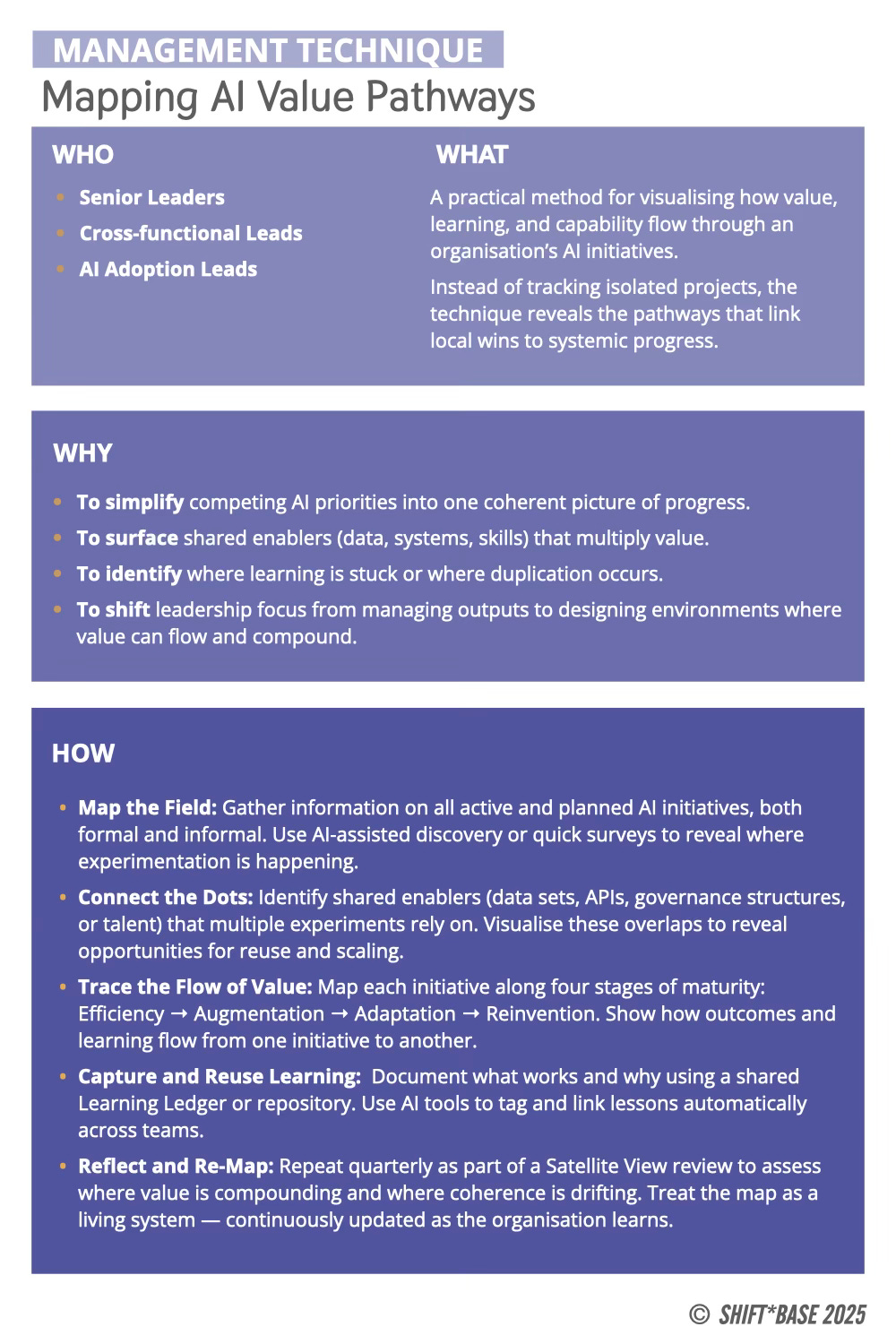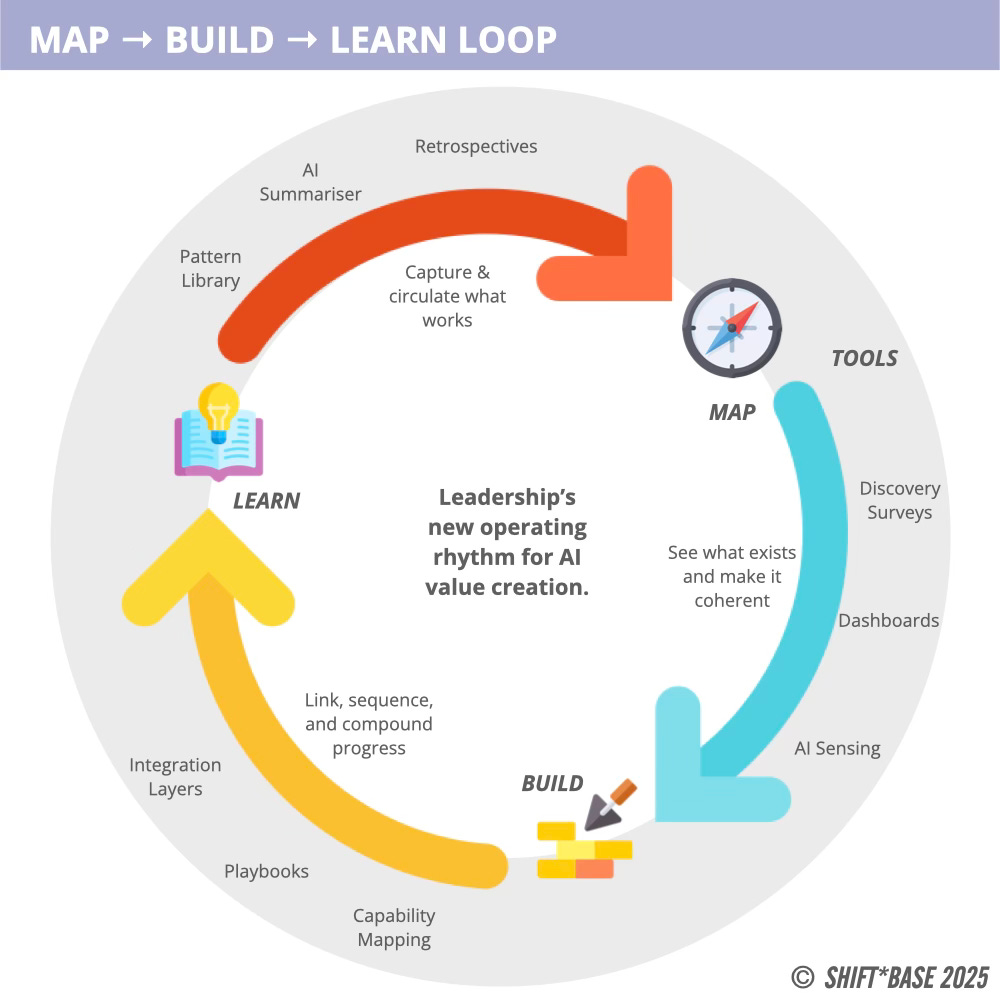Mapping AI Value Pathways
How leaders can use a simple Map → Build → Learn loop to turn scattered AI pilots into a coherent organisational world of value.
Hello from Japan, where I have been facilitating the final conference of a leadership learning programme we have been running for a large tech firm. Being back here again has reminded me of the quiet rigour of Lean thinking - the art of seeing complexity clearly and improving systems through simplicity. It is a useful lens for this moment in AI adoption, when enterprises are drowning in individual initiatives but lacking overall coherence.
Amid the rush to deploy AI tools in the enterprise, leaders are faced with a lot of competing priorities at different levels of scale. With tech teams racing ahead to develop the tooling, platforms and integrations needed to enable enterprise AI to function, it is tempting for business leaders to get drawn into the minutiae of development. But their time is better spent on the wider challenge of how to turn technology capabilities into business capabilities, how to create the environment and context within which enterprise AI can flourish, and the team skills and behaviours to make this happen.
In our recent piece on world-building, we described how leadership is shifting from managing outputs to designing the worlds where humans and AI work together. Mapping AI Value Pathways operates within that System layer - it’s the practical method for shaping the organisation’s “physics,” ensuring that every AI experiment strengthens, rather than fragments, the world it inhabits.
Whilst individual AI pilots and experiments are important as part of the rapid learning and evolution that this new technology brings to the workplace, we also need to focus on how to create intelligent environments and systems, not just individual applications. Every AI experiment generates value locally, but without shared context and integration, it might not deliver compounding value.
A marketing team model that rewrites content at speed, but with a tone that breaks brand values. A finance pilot that reduces processing time, but uses data defined differently across systems. A supply-chain agent that optimises for efficiency, but erodes resilience. Each might pass narrow acceptance testing, but without oversight and management they can create inconsistency.
And in the absence of coherence, leadership often defaults to more control - centralising decisions, adding governance layers, or outsourcing direction to vendors. Yet what’s needed isn’t more control, but world-building and workplace design: a way to see and shape how these separate experiments fit together into a single, evolving environment of value creation.
This is where mapping AI value pathways can really help, by revealing how value actually travels through the organisational world: what connects, what repeats, and what compounds.
It can help leaders see three simple things:
Where the energy already is.
How local wins can link to systemic gains.
What environmental conditions allow or inhibit value flow.
Instead of asking “Where should we deploy AI next?”, leaders can start asking “What kind of world are we building, and how do today’s pathways shape it?”
The job is no longer to manage every experiment or predict every outcome, but to ensure that the world those experiments live in (its rules, connections, and feedback loops) enables learning, coherence, and cumulative value.
Before AI can transform the organisation, leaders must transform their view of the organisation itself as a living world of evolving pathways, waiting to be mapped.
Projects → Pathways
Last week, we explored world-building as a new leadership discipline, the craft of designing the organisational “physics,” “culture,” and “geography” that allow humans and AI to thrive together.
Mapping AI Value Pathways lives squarely within that System layer of world-building. It gives leaders a way to understand and shape the underlying physics of value creation: how progress travels, compounds, and maintains coherence across the organisation.
In most enterprises today, AI work typically happens within projects: discrete pilots, proofs of concept, and platform upgrades that begin and end in isolation. Progress is measured in deliverables, but this project-based logic disrupts what should be a cumulative change. It produces movement without momentum, a steady hum of activity without a visible storyline of progress.
Pathways are different. They connect experiments into evolving routes where each step builds on what came before, and where value is measured not only in outputs, but in how much the organisation itself learns and adapts.
When leaders shift from managing projects to mapping pathways, they can simplify and connect the emerging AI landscape. Dozens of competing priorities resolve into one repeating loop, Map → Build → Learn, that keeps effort aligned, visible, and compounding.
This practice draws on a familiar, tried-and-tested discipline from Lean management practice: Value Stream Mapping. But whilst traditional value streams captured the flow of materials and effort through a process, AI Value Pathways capture the flow of learning, data, and capability through a living system.
Where Value Stream Mapping helped leaders eliminate waste, Value Pathway Mapping helps eliminate fragmentation, revealing how local innovation connects and strengthens the whole. It’s Lean thinking reimagined for the age of AI: less about process flow, and more about learning flow.
By treating pathways as the connective tissue of their emerging AI-enhanced world, leaders begin to practice world-building in its simplest form, designing environments where every experiment, no matter how small, contributes to the evolving coherence of the organisation.
Lightweight System Design for Value Mapping
Every leader today juggles multiple AI priorities at very different levels of scale: platforms to evaluate, ethics to define, governance to satisfy, pilots to prove.
Pathways simplify this landscape. They replace long lists with visible routes, showing which experiments unlock the next layer of capability development.
The goal of mapping AI value pathways is not to introduce another layer of programme management or governance, but to make progress visible and reduce friction in how value emerges. The system should feel light, adaptive, and self-updating, less like a reporting mechanism, more like a shared sense-making surface.
In our AI world-building framework, this sits in the System layer: the organisational physics that determine how ideas, data, and capabilities flow. Leaders don’t need a new process; they need a few well-designed mechanisms that reveal where learning travels and where to amplify it.
The Leadership Shift
The Map → Build → Learn loop achieves alignment through visibility and feedback.
It’s the essence of world-building at the system level: leaders don’t manage every action; they maintain the physics of progress, ensuring that every experiment lives in the same gravity field of shared understanding.
Simplification doesn’t mean doing less. It means seeing better, so that what you do adds up.
Example: The Pathway Effect in Action
Imagine a global manufacturing firm beginning its AI journey in the most familiar way - dozens of small, local experiments.
A maintenance team uses predictive models to spot machine failure.
A logistics unit prototypes a scheduling assistant.
A procurement group trials a copilot to summarise supplier risk.
Each effort delivers measurable gains but remains trapped in its own context.
When the organisation applies AI Value Pathway Mapping, the picture changes.
Mapping exposes shared enablers, the same telemetry data feeding maintenance and logistics, the same governance model guiding supplier intelligence.
Leaders connect these dots into a single, visible route:
Efficiency: Predictive maintenance improves uptime.
Augmentation: Logistics AI links the same sensor data to automate delivery routing.
Adaptation: Procurement agents learn from both streams to anticipate supply disruption.
Reinvention: A cross-function AI control tower now orchestrates the full chain in real time.
Each step builds on the previous one. Instead of scattered pilots, the company now has a pathway of compounding value that turns local wins into a shared, data-rich capability.
Learning captured in the Learning Ledger informs the next design cycle; patterns harvested from one function accelerate adoption in others.
Within a few months, leadership can trace how value actually travels: from raw data to decision advantage, from efficiency to resilience.
This is the pathway effect: visible, cumulative progress that builds coherence rather than complexity.
It demonstrates that AI adoption doesn’t need to be centralised to be strategic. It simply needs to be connected.
By making those connections explicit, leaders transform AI from a set of parallel projects into a living system of evolving capability, the organisational equivalent of a well-designed world whose rules, feedback loops, and physics now make sense.
Keep reading with a 7-day free trial
Subscribe to Shift*Academy to keep reading this post and get 7 days of free access to the full post archives.




